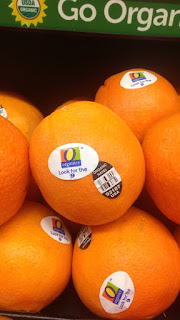Sacks states that it's always good to know where your food has been, or a your food's "food footprint." You can find out if the produce is local or if it has traveled across the country by checking the sticker on the side. She says to "learn where your fruits and veggies come from...If you know the origin of your produce, then you have an idea of how long it took to travel to you"(191). I wanted to find the most from just the sticker of these oranges, using Sacks's tip to use these codes:
Conventional Produce- four-digit code
Organic Produce- five-digit code with a 9
Genetically Modified Produce- five-digit code starting with an 8
 I traveled through the produce section to find all the different types of codes. Everything was conventional produce that wasn't obviously labeled organic. I couldn't find any five-digit codes that started with an 8, Sacks stated that this genetically modified sticker isn't being used often (190). I expected not to see any of these codes because having GMOs in produce isn't that popular and most companies don't want to show that their produce is modified.
I traveled through the produce section to find all the different types of codes. Everything was conventional produce that wasn't obviously labeled organic. I couldn't find any five-digit codes that started with an 8, Sacks stated that this genetically modified sticker isn't being used often (190). I expected not to see any of these codes because having GMOs in produce isn't that popular and most companies don't want to show that their produce is modified.
The products that were organic were obviously organic, I didn't even need to look at the code. Organic products are viewed in a positive way so they show it whenever they can. They even had a sticker next to the sticker to look for the 9 in the code.
I really wanted to find a product that was genetically modified but this trip to the produce section was uneventful. Now I know what to look for if I ever go to the a store that uses these codes.
Have you ever paid attention to these codes? What did you think they could've meant?
Sacks, Stefanie. What the Fork Are You Eating?: An Action Plan for Your Pantry and Plate. New York: Penguin Group, 2014. Print.

0 comments:
Post a Comment